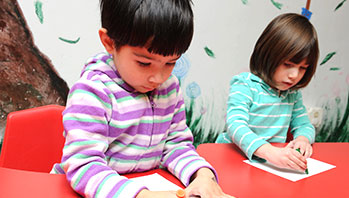- chart paper
- marker
- dear
- letter
- wolf
MA Standards:
English Language Arts/Foundational Skills/RF.PK.MA.1 With guidance and support, demonstrate understanding of the organization and basic features of printed and written text: books, words, letters, and the alphabet.
English Language Arts/Writing/W.PK.MA.1 Dictate words to express a preference or opinion about a topic (e.g., “ I would like to go to the fire station to see the truck and meet the firemen.”)
Head Start Outcomes:
Language Development/Expressive Language Uses language to express ideas and needs.
Literacy Knowledge/Early Writing Recognizes that writing is a way of communicating for a variety of purposes, such as giving information, sharing stories, or giving an opinion.
Literacy Knowledge/Early Writing Uses scribbles, shapes, pictures, and letters to represent objects, stories, experiences, or ideas.
PreK Learning Guidelines:
English Language Arts/Composition 16 Use their own words or illustrations to describe their experiences, tell imaginative stories, or communicate information about a topic of interest.
Draw and Write Together: Letter to the Big Bad Wolf

© Commonwealth of Massachusetts, Department of Early Education and Care (Jennifer Waddell photographer). All rights reserved.
ELA Focus Skills: Comprehension, Concepts of Print, Sequencing, Story Structure
Invite children to write a letter to the big bad wolf from the stories they have read about him. Write the letter on chart paper for children to see. As children dictate their ideas, think out loud as you write. Say, When we write a letter to someone, we include a greeting, such as “Dear Wolf.” I’ll write a greeting to the wolf here: “Dear Mr. Wolf.”
Make an exaggerated sweep down to the next line and say, Then we start to write the letter below the greeting. Say, What do you want to say to the wolf? Prompt discussion with questions, such as,
- What do you think about the wolf trying to blow the pigs’ houses down? What would you like to say to him about that?
- What do you think about the wolf’s story in the book Tell the Truth, B. B. Wolf? What would you like to say to him about that?
- Were you happy that he did something nice for the pigs as a way of saying he was sorry?
When children finish dictating, say, We need to end our letter. When we end a letter we use a closing. We could say something like “Your Friends,” “Love,” or “Sincerely.” What do you think we should say? Write children’s choice at the bottom of the letter. Invite them to come up and add their names or initials. If children ask, tell them you will deliver the letter to the wolf.
Social Emotional Tip: Talk with children about the qualities often valued in a person’s character, such as honesty, kindness, fairness, trustworthiness, and personal responsibility.
Adaptation: If younger children have difficulty putting their thoughts into words, have them draw a picture to show how they feel about the behavior of the wolf.
English Language Learners: If English language learners have trouble putting their ideas into words, let them pantomime; then you can explain what words to use.
